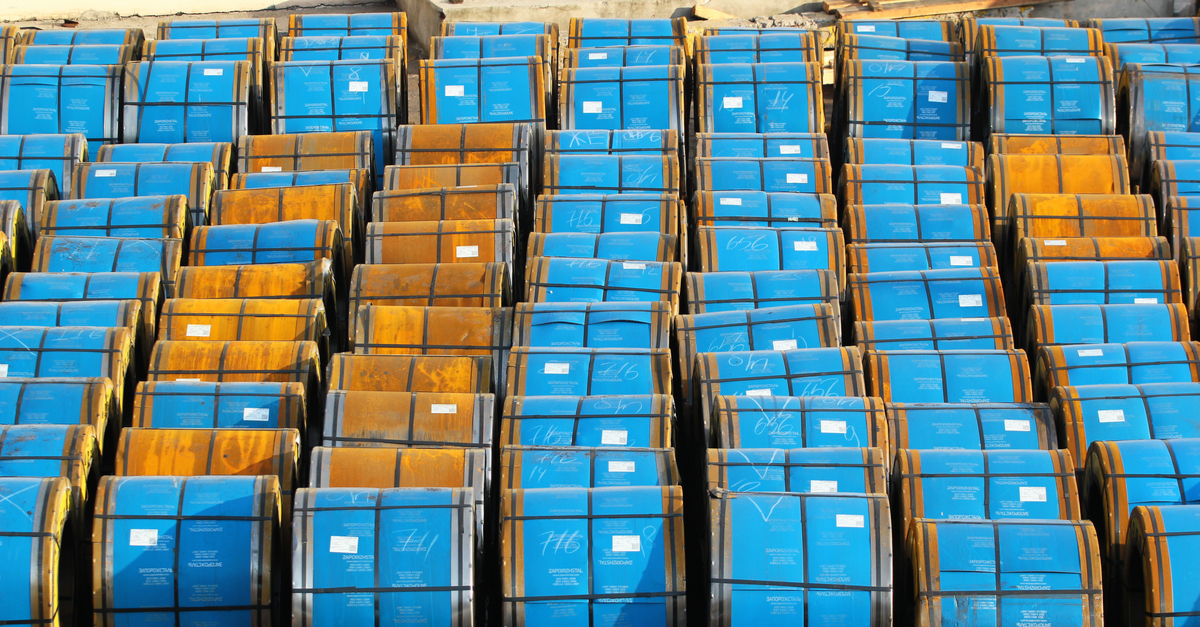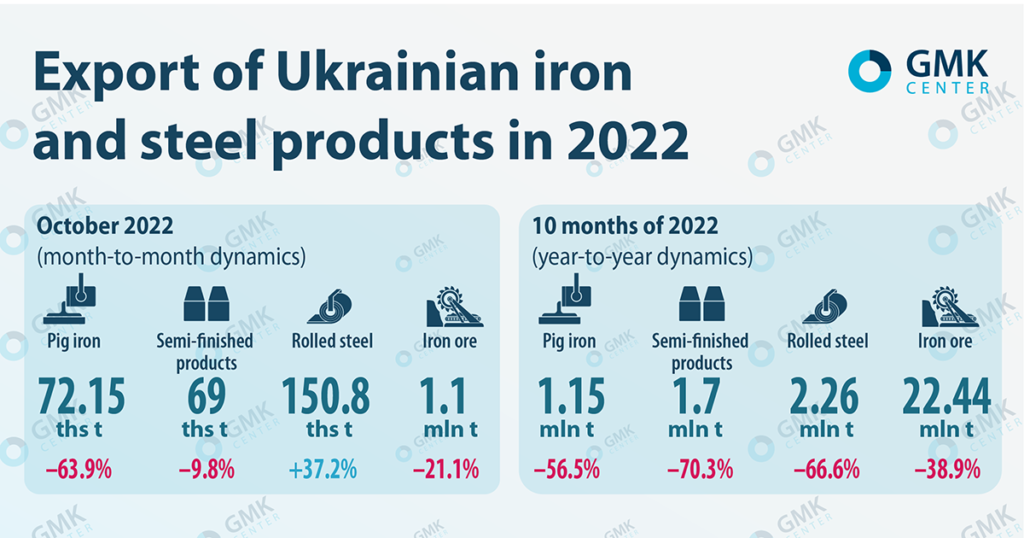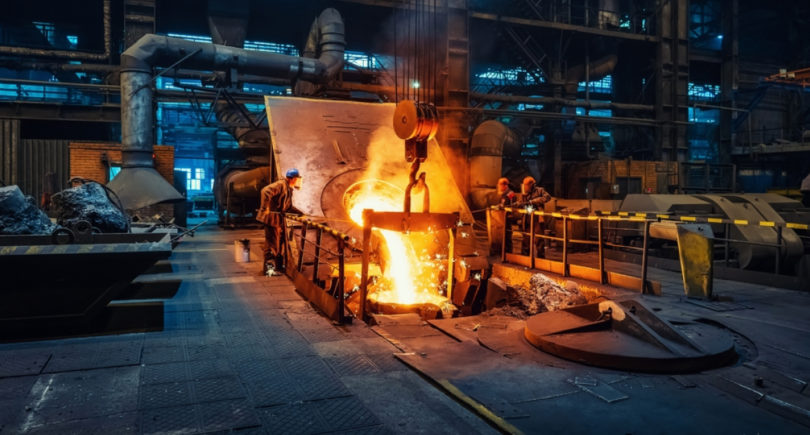
Posts Industry Ukraine’s mining & metals sector 3638 18 November 2022
The critical situation can only be improved by opening access to seaports for cargoes from the iron and steel industry
By most indicators of iron and steel production, October was the worst month for exports in 2022. The results of the industry were negatively affected by a combination of problems – missile attacks on the country’s energy infrastructure, ongoing difficulties with logistics due to the blockade of Ukrainian ports and weak domestic demand.
October recession
In October 2022, the export of iron and steel products showed a predominantly negative monthly trend:
- pig iron – a decrease of 63.9%, or 127.7 thousand tons, compared to September 2022;
- semi-finished products – a decrease of 9.8%, or 7.5 thousand tons;
- rolled products – an increase of 37.2%, or 40.8 thousand tons;
- iron ore – a decrease of 21.1%, or 0.3 million tons.
The most massive export product of Ukrainian steel sector is iron ore. In October, shipments of Ukrainian iron ore abroad amounted to 1.1 million tons, which is the lowest figure for a month in 2022. At the same time, in 2021, the worst monthly indicator of iron ore exports amounted to 3.7 million tons for $270 million (in December). The maximum was in May 2021 – 4.3 million tons for $788.4 million.
In general, for 10 months of 2022, exports of iron and steel products amounted to:
- pig iron – 1.15 mln t (-56.5% y/y);
- semi-finished products – 1.7 million tons (-70.3% y/y);
- rolled products – 2.26 mln t (-66.6% y/y);
- iron ore – 22.44 million tons per (-38.9% y/y).
“The critical situation in the Ukrainian steel sector, unfortunately, is only getting worse with every month of the war. In January-October, the production of steel products decreased by 67% compared to the same period in 2021,” says Oleksandr Kalenkov, President of the Ukrmetallurgprom Association of Enterprises.

Export of Ukrainian iron and steel products in 2022 GMK Center
Influencing factors
The situation in the Ukrainian steel sector is influenced by many factors caused by the war. The industry, which by October had already largely adapted to the difficult working conditions during the war, faced a new and most serious problem – the limitation of electricity supplies.
October and November Russian missile attacks on the country’s energy infrastructure caused damage for steel enterprises. For obvious reasons, the industry’s enterprises do not disclose its exact size and nature, but it is known that in October-November there were partial and complete shutdowns of production.
Another important factor is low prices and weak demand for steel products in the European market. After the Russian invasion, Europe became practically the only market for Ukrainian steel products. Steel production in Europe is expected to fall by 4% in 2022 y/y due to shutdown of capacities and decrease in production, while the consumption of steel products in the EU will fall by 3.5% y/y.
The logistical problems of iron and steel enterprises have not disappeared anywhere, and the cost of logistics has increased many times over compared to the pre-war level. But the main thing is the limited capacity of logistics routes. The closure of ports led to the transfer of much of the logistics to the railway, but the western border crossings turned out to be a bottleneck.
“Some border crossings and infrastructure do not always cope with the flow of goods between Ukraine and Poland. From time to time, an imbalance arises, which entails further problems due to the introduction of conventions – a ban on the export of a certain type of cargo or restrictions for specific enterprises. These sudden bans can be imposed by both Ukrzaliznytsya and Polish railways. This happens, for example, due to the accumulation of railcars at the border. Conventions are introduced to optimize cargo flows and establish a certain balance. But at the same time, the business and its customers find themselves in a situation of uncertainty regarding the delivery of orders,” notes Andriy Myagkov, Logistics Director at ArcelorMittal Kryvyi Rih.
The only export waterway is the Danube ports. However, now they are occupied with grain cargoes and cannot provide all the necessary transshipment for the enterprises of the iron and steel complex.
In this situation, only the restoration of iron and steel products exports through Ukrainian seaports can save the industry. The Ukrainian authorities expressed a desire to expand the list of products under the grain deal, but the program was extended for four months without taking it into account.
Also, for iron and steel enterprises, as well as for a significant part of exporters, the problem of VAT reimbursement by the state remains relevant. Currently Ukrainian business complains for groundless blocking of tax invoices for VAT by the State Tax Service of Ukraine.
All these factors are forcing steel enterprises to suspend the operation of their facilities, work with a reduced production load and maintain their personnel accordingly.
“Enterprises have long been operating at a loss and in the current environment can barely cover 70% of their variable costs. On average, iron and steel enterprises (including mining) operate at 20% of the pre-war load level, and steel plants, in particular, at 15%, taking into account temporarily lost capacities in Mariupol,” emphasizes Alexander Kalenkov.
Need solutions
If this situation in the steel sector continues, it threatens the entire country, since Ukraine’s budget is half dependent on Western loans and grants. At the same time, the adoption of effective decisions to improve the working conditions of the industry could increase foreign exchange earnings from exports, this will support both the steel sector and the entire economy of the country. After all, minings and steel plants operate at only 25-50% of their real capacity.
There is potential to increase export earnings, but at the moment there is a negative trend. In October, proceeds from the export of ferrous metals from Ukraine decreased by 21.4% – to $189.8 million compared to $241.45 million in September. In general, over ten months, revenue from the export of ferrous metals collapsed by 64% – to $4.15 billion.
In solving the problems of the iron and steel complex, point decisions of the authorities would help. Dialogue between government and industry is ongoing, in August the Cabinet of Ministers even created Economic Headquarters to address urgent economic issues. However, to this day no decisions have been made that could significantly improve the current situation for the industry.
“Only opening access to seaports for iron and steel cargo can improve the situation in the current military conditions. In the event of an increase in export volumes, enterprises will be able, if not to reach zero, then at least to cover more of the necessary costs and retain labor collectives. That is why Ukrmetallurgprom, on behalf of the industry’s enterprises, constantly calls on diplomat officials to agree with our international partners on expanding the range of goods exported within the “transport corridor”. This decision will not only improve the state of iron and steel enterprises, but also significantly increase the amount of taxes and foreign exchange earnings in Ukraine,” sums up Olexander Kalenkov.





